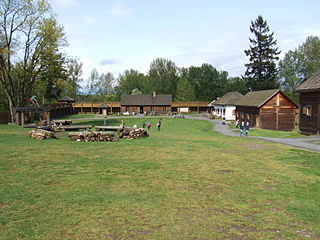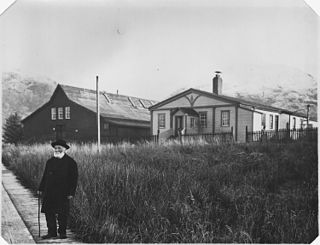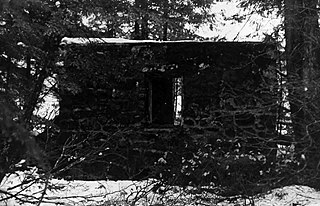
Southeast Alaska, colloquially referred to as the Alaska Panhandle or Alaskan Panhandle, is the southeastern portion of the U.S. state of Alaska, bordered to the east by the northern half of the Canadian province of British Columbia. The majority of Southeast Alaska's area is part of the Tongass National Forest, the United States' largest national forest. In many places, the international border runs along the crest of the Boundary Ranges of the Coast Mountains. The region is noted for its scenery and mild, rainy climate.

Hyder is a census-designated place in Prince of Wales-Hyder Census Area, Alaska, United States. The population was 87 at the 2010 census, down from 97 in 2000. Hyder is accessible by road only from Stewart, British Columbia, and is popular with motorists wishing to visit Alaska without driving the length of the Alaska Highway and is otherwise landlocked. It is the southernmost community in the state that can be reached via car. Hyder is Alaska's easternmost town.

Eagle is a city on the south bank of the Yukon River near the Canada–US border in the Southeast Fairbanks Census Area, Alaska, United States. It includes the Eagle Historic District, a U.S. National Historic Landmark. The population was 86 at the 2010 census. Every February, Eagle hosts a checkpoint for the long-distance Yukon Quest sled dog race.

Eagle Island is an island in Maine's Casco Bay and the site of the retirement home of the polar explorer Admiral Robert Peary (1856-1920). The island and home are preserved as the Eagle Island State Historic Site.

Fort Langley National Historic Site, commonly shortened to Fort Langley, is a former fur trading post of the Hudson's Bay Company in the community of Fort Langley of Langley, British Columbia, Canada. The national historic site sits above the banks of the Bedford Channel across McMillan Island. The national historic site contains a visitor centre and a largely reconstructed trading post that contains ten structures surrounded by wooden palisades.

The Kake Cannery is a historic fish processing facility near Kake, Alaska. Operated by a variety of companies between 1912 and 1977, the cannery was one of many which operated in Southeast Alaska, an area historically rich in salmon. The cannery's surviving buildings are among the best-preserved of the period, and provide a window into the labor practices of the cannery operators, which emphasized production over working conditions, and made significant use of immigrant contract workers. It was declared a National Historic Landmark in 1997.

Allenville Mill Storehouse is a historic mill storehouse at 5 Esmond Street in Esmond, Rhode Island within the town of Smithfield, Rhode Island. The exact date of construction is unknown, but it was built with rubble masonry construction which was typical of mill construction during and after the War of 1812. In 1813, Phillip Allen purchased 4.5 acres of land and constructed a mill on the site, but the first record to specifically refer to the storehouse was an insurance policy from 1836. Allen sold the property in 1857 and it changed ownership several times before it became Esmond Mills in 1906. In 1937, the building was used as a post office and described erroneously as the "Old Allenville Mill". The building has had some alterations to the front door and possibly the addition of a side door, but the interior of the structure was not detailed in the National Register of Historic Places nomination. The Allenville Mill Storehouse was added to the National Register of Historic Places in 1972.

The North Canal Historic District of Lawrence, Massachusetts, encompasses the historic industrial heart of the city. It is centered on the North Canal and the Great Stone Dam, which provided the waterpower for its many mill complexes. The canal was listed on the National Register of Historic Places in 1975, while the district was first listed in 1984, and then expanded slightly in 2009.

This is a list of the National Register of Historic Places listings in Prince of Wales–Hyder Census Area, Alaska.

There are 70 properties listed on the National Register of Historic Places in Albany, New York, United States. Six are additionally designated as National Historic Landmarks (NHLs), the most of any city in the state after New York City. Another 14 are historic districts, for which 20 of the listings are also contributing properties. Two properties, both buildings, that had been listed in the past but have since been demolished have been delisted; one building that is also no longer extant remains listed.

Shoal Tower, originally known as Victoria Tower, is a Martello tower located in the harbour of Kingston, Ontario, Canada, directly opposite Kingston City Hall. It is one of four such towers built in the 1840s to protect Kingston's harbour and the entrance to the Rideau Canal. Cathcart Tower on Cedar Island, Shoal Tower in the Confederation Basin, Fort Frederick on the grounds of the Royal Military College of Canada, and Murney Tower were part of the same strategic improvements. Although 16 Martello towers were built in Canada, only 11 are still standing, four of them in Kingston.

The Nashua Manufacturing Company Historic District in Nashua, New Hampshire, is a historic district that was listed on the National Register of Historic Places (NRHP) in 1987. It encompasses an area just west of downtown Nashua, roughly located along the southern bank of the Nashua River, bordered on the west side by Mine Falls Park, on the south side by the Nashua River canal, up to Ledge Street, and from the east side by Factory, Pine and Water streets, up to the Main Street bridge.

The Woodchopper Roadhouse, on the Yukon River, is a historic establishment that was built in approximately 1910. It is located in the Yukon-Charley Rivers National Preserve. It served as a hotel and as a post office. Its log building was listed on the National Register of Historic Places in 1987.

Elmer S. Dailey, originally known as the Claire B. Follette, is a wooden barge built by William H. Follette in 1915 at Tonawanda, New York, and rebuilt and renamed in 1928 by Brown Drydock on Staten Island, New York. It was used to transport materials from New York, New Jersey and Connecticut. It is the only known surviving Erie Canal boat and is one of a few remaining wooden-hulled canal boats. It sank in 1974 along with the Priscilla Dailey and the Berkshire No. 7 in the harbor of Bridgeport, Connecticut on the west side of the Pequonnock River. It has deteriorated to the point that a salvage operation could result in it breaking apart. It was added to the National Register of Historic Places on December 21, 1978.

Priscilla Dailey, previously known as the Elizabeth E. Newell, is a wooden canal boat constructed in 1929 in Whitehall, New York. The barge was used to transport bulk cargo in New York, New Jersey, and Connecticut harbors. It sank in 1974 along with the Elmer S. Dailey and the Berkshire No. 7 in the harbor of Bridgeport, Connecticut on the west side of the Pequonnock River. The sunken boat has deteriorated to the point that a salvage operation could result in it breaking apart. It was added to the National Register of Historic Places on December 21, 1978.

The Father William Duncan House, also known as the Father Duncan Cottage and now hosting the Duncan Cottage Museum, is a historic house located at 501 Tait Street in Metlakatla, Alaska. The single-story wood frame structure was built in 1891 by the Tsimshian followers of the Anglican missionary William Duncan. It was one of the first structures built in Metlakatla after Duncan led a small number of followers there from the like-named village in British Columbia. The front facade is faced in shiplap siding, with four evenly spaced pilasters. There is decorative woodwork in the shallow-pitch gable end. Duncan was an influential leader of the community until his death in 1918.

Storehouse No. 3 is one of four historic storehouses built by the United States Army along the Portland Canal on the west coast of North America. Built out of rubble stone in 1896, they were built at a time of tension with neighboring Canada over exact location of the international border in the area. The border location was resolved by arbitration in 1903, with two of the four warehouses falling in Canadian territory. None of the warehouses were apparently ever used. Storehouse No. 3 is located on Halibut Bay, on the northwest side of the Portland Canal. The storehouse was listed on the National Register of Historic Places in 1977.

The Dr. Elmer Bly House, also known as Bly House and The Point, is a historic log house in Port Alsworth, Alaska. It is located on a spit of land adjacent to Hardenburg Bay, an inlet of Lake Clark, and presently houses administrative offices of the Lake Clark National Park and Preserve. The house is a 1-1/2 story log structure, measuring 23 by 37 feet. It has a projecting screened arctic entrance vestibule measuring 10 by 13 feet. The logs used in its construction are sawn on three sides at a local sawmill. The house was built in 1947 by Dr. Elmer Bly, a dentist, and Joe Thompson. Bly operated his dental practice here from 1947 to 1953. It was purchased by the National Park Service 1979, at which time the interior was modernized and the exterior rehabilitated.

Libby's No. 23 is a historic sail-powered fishing vessel, now on display at the Lake Clark National Park and Preserve visitors center in Port Alsworth, Alaska. Built in 1914, she served in the salmon fishery of Bristol Bay until about 1951, owned by the Libby's cannery and worked by two-man crews. She is 29 feet 6 inches (8.99 m) long, with a beam of 9 feet 2 inches (2.79 m) and a depth of 4 feet (1.2 m). Its bow and stern are roughly the same shape, giving the style its name. Despite its use for freight and recreation between 1953 and 1997, the boat has retained much of its original equipment, and was fully restored by the National Park Service between 1998 and 2005, acquiring replacement parts from similar boats and removing an added motor. It is normally rigged with a mainsail and spritsail, but these are only raised when the boat is taken out of its custom-built boathouse.





















